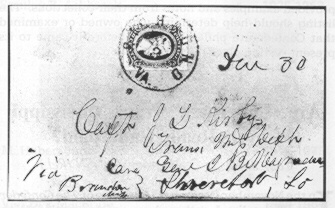

This article is from the September-October 2000 issue of the Confederate Philatelist. Posted with the permission of the journal editor.
In the November-December 1994 issue of The Confederate Philatelist, I authored an article entitled "Non-Express (Underpaid) Trans-Mississippi Covers." Based on correspondence and discussions with fellow Confederate philatelists, plus recently discovered Confederate Post Office Department documentation, I have now come to the conclusion that the term "underpaid" Trans-Mississippi covers is inaccurate.
A little background is necessary. In June 1984, the Philatelic Foundation published Colonel Richard Krieger's monograph on the Trans-Mississippi mails after the Fall of Vicksburg, Mississippi, on July 4, 1863. Colonel Krieger updated his monograph on August 6, 1986, with newly reported covers that had been brought to his attention by readers of his comprehensive study. The term "underpaid Trans-Mississippi covers" was used by Colonel Krieger and is most likely the reason why it is now commonly used by many Confederate philatelists and dealers. My article was an update on "underpaid" Trans-Mississippi covers -- those that were transmitted entirely within the Confederate postal system after the Fall of Vicksburg, and reflected a payment of less than 40 cents.
Since my article, a letter from B. N. Clements, Chief of the Appointment Bureau, Confederate Post Office Department, dated December 11, 1863, has come to light. It states in part "... no letters can be sent by the express mail without the payment of Express postage, except those on the business of this Department. Soldiers letters which are franked must go by the ordinary modes of conveyance and should be sent forward by the ordinary mail, and the Postmasters, marking such letters for the Express Mail should be notified, that they cannot be sent by that mail, but have been forwarded by the ordinary mail."2 This clearly implies that Trans-Mississippi letters could be sent by ordinary mail notwithstanding the availability of the 40-cent express mail program. More importantly, there is no Confederate Post Office Department regulation or record stating that the newly established 40-cent Trans-Mississippi express mail rate was mandatory and the 10-cent ordinary rate for Trans-Mississippi mail was no longer authorized.
Another bit of evidence suggesting that the 10-cent ordinary rate for Trans-Mississippi mail after the Fall of Vicksburg was not discontinued is the fact that almost all "underpaid" Trans-Mississippi covers do not have a "Due 30" notation. As Colonel Jack Molesworth, a longtime Confederate philatelic dealer, observed in correspondence to me on this subject, "I am rather sure the very efficient CSA Post Office would have marked postage due or indicated somewhere on the cover that it was underpaid." I have only seen one Trans-Mississippi cover sent after the Fall of Vicksburg that has a "Due 30" notation, and it is illustrated below.
 |
In summary, the current evidence indicates that the 10-cent ordinary rate was not suspended for Trans-Mississippi mail service after the Fall of Vicksburg. The fact that these 10-cent covers are far outnumbered by their 40-cent cousins does not in itself support that they are "underpaid." Rather it is my belief that the numbers are only a reflection of the CSA postal patrons preference for faster mail service between the states east and west of the Union controlled Mississippi River. Accordingly I believe the term "underpaid" Trans-Mississippi covers is misleading and should no longer be used. Instead the term "non-express" Trans-Mississippi covers would seem more accurate and its use is recommended.
References:
Editors' Commentary (Stefan Jaronski):
Too often we assume that what we read in this journal, in other philatelic publications, and even in news media is the final word, the truth about a particular subject. Then we get confused when contradictory information appears. What is the truth?
In scientific research a theory lasts only until it is disproven by additional information. Once the Sun orbited around the Earth. Then Copernicus proposed the opposite. Eventually his theory was supported by more data and accepted. Now the Earth revolves around the Sun.
Postal history is no different. The preceding article is an excellent example of the evolution of our knowledge about postal history. Col Monroe's original theory about the Trans-Mississippi rates was incorrect. Additional information changed his view. Thus we progress. That's why we publish articles with which we may not entirely agree. Certainly, an author's assertions are examined, but unless they have already been proven incorrect they see print.

 Return to Top of Page
Return to Top of Page 
